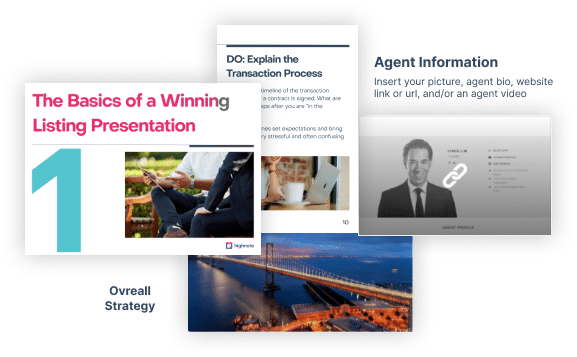This is a real estate complete guide to writing a winning real estate listing presentation.
In this comprehensive guide, you’ll learn:
- How to research your audience, property, market, and competition
- How to define your unique selling proposition and stand out from the competition
- How to create an outline and structure your presentation for maximum impact
- How to deliver an engaging introduction and showcase the property effectively
- How to close the presentation and win more listing
If you’re looking to take your real estate business to the next level and win more listings, this guide is for you.
So let’s dive right in and learn how to write a listing presentation that will impress your clients and help you close more deals for future potential clients

1. Understand Your Audience
To write a compelling listing presentation, you must understand your audience. This includes the client, the property, the market, and the competition.
Research the Client
Understanding the client’s needs, preferences, and expectations is key to creating a listing presentation that will resonate with them.
Consider the following when researching the client:
- Their personal and professional background
- Their motivations for selling the property
- Their timeline for selling the property
- Their communication style and preferred methods of contract
Research the Property
Knowing the details and unique features of the property is essential for creating a listing presentation highlighting the property’s strengths.
Here are some things to consider when researching the property:
- The property’s location, size, and age
- The property’s layout, features, and amenities
- Any renovations, upgrades, or repairs that have been made
- Any potential issues or challenges that may affect the sale of the property
Research the Market
Understanding the local real estate market is crucial for developing an effective pricing and marketing strategy.
Here are some things to consider when researching the market:
- Recent trends in the local real estate market
- Average home prices and average days on the market
- The current supply and demand for homes in the area
- The competition and how their properties compare to the client’s property
Research the Competition
Analyzing the competition can give you a competitive edge in your listing presentation.
Here are some thing to consider when researching the competition:
- The number of similar properties on the market
- The price, condition, and features of competing properties
- The marketing strategies of competing real estate agents
- Any unique selling points or weaknesses of competing properties
2. Define Your Unique Selling Proposition

A unique selling proposition (USP) is a statement that describes what sets you apart from the competition. You USP should be the foundation of your listing presentation. It should communicate why the client should choose you are their agent.
Determine Your Strengths and Differentiators
Consider your strengths, skills, and experience when developing your USP.
Ask yourself the following questions:
- What skills and experience do I have that sets me apart from other agents?
- What unique value do I bring to the table?
- What results have I achieved for previous clients?
Craft Your USP
Use the information you gathered to create a clear and concise USP that highlights your strengths and differentiators. Your USP should be easy to remember and communicate to the client.
Example USPs:
- “I use the latest technology and marketing strategies to sell homes faster and for more money.”
- “As a lifelong resident of this area, I have an unparalleled knowledge of the local market and community.”
- “I have a proven track record of exceeding my client’s expectations and achieving record-breaking sales.”

The Advanced System to Winning More Listings
Created by industry veterans, discover the advanced system to winning more listings with this guide. Stand out, shine, and become a listing machine!
Proven System that has won Thousands of Listings. Over $3B and counting!

Just enter your email and get it for free.
3. Develop an Outline
Creating an outline is essential for organizing your thoughts and ensuring that you cover all the necessary topics in your listing presentation.
Determine the Key Topics to Cover
Consider the topics that will be most relevant and interesting to your audience.
Here are some topics that will be most relevant and interesting to your audience.
Here are some topics that you may want to include in your outline:
- Introduction and background
- You unique selling proposition
- Your marketing plan
- Pricing strategy and market analysis
- Property Details and features
- Closing and call to action
Organize Your Outline
Arrange your topics in a logical and easy-to-follow order. Consider using subheadings and bullet points to make the information more accessible.
Example Outline:
I. Introduction and Background
- Personal introduction
- Company background
II. Unique Selling Proposition
- My skills and experience
- How can i help the other client
- My proven results
III. Marketing Plan
- Overview of my marketing approach
- Marketing channels to be used
- Timeline for marketing activities
IV. Property Details and Features
- A visual tour of the property
- Property features and amenities
- Upgrades or renovations
- Potential challenges and solutions
V. Closing and Call to Action
- Recap the benefits of working with me
- Call to action and next steps
- Follow-up plan

4. Create an Engaging Introduction
The introduction is your chance to make an excellent first impression and set the tone for the rest of the presentation.
Grab the Client's Attention
Use a personal story, interesting statistic, or relevant information to capture the client’s attention.
Here are some examples:
- “Did you know that homes in this area sell for an average of 15% above the listing price?”
- “As a fellow dog lover, I noticed the dog park down the street from your property.”
- “I am passionate about helping homeowners achieve their dreams, and I believe I can help you too.”
Build Rapport with the Client
Use the introduction to connect with the client. Here are some ways to build rapport:
Ask questions to learn more about the client’s needs and preferences
Use humor or storytelling to break the ice
Express empathy for any challenges the client may face

5. Highlight Your Company's Background
A brief company history and overview can give the client confidence in your abilities and expertise.
Share Your Company's History
Explain how your company was founded and any essential milestones or achievements. Here are some examples:
“Our company has been in business for over 20 years, and we’ve helped thousands of homeowners sell their properties.”
“Our team of agents has over 50 years of combined experience in the local real estate market.”
Emphasize Your Company's Values
Highlight your company’s values and mission and how they align with the client’s needs. Here are some examples:
“Our company is committed to providing exceptional service and achieving the best results for our clients.”
“We pride ourselves on our honesty, integrity, and professionalism.”

6. Explain Your Unique Selling Proposition
Use this section to explain what sets you apart from the competition and why the client should choose you as their agent.
Highlight Your Skills and Experience
Describe your skills and experience that make you the best choice for the client.
Here are some examples:
“I have over ten years of experience in the local real estate market and have sold over 100 properties.”
“My negotiation skills are unmatched, and I’ve helped many clients get the best price for their property.”
Focus on the Client's Needs
Please explain how your unique selling proposition benefits the client and addresses their needs.
Here are some examples:
“My marketing approach will help you sell your property faster and for more money.”
“My local market knowledge will help you price your property competitively and attract the right buyers.”

7. Present Your Marketing Plan
This section should describe your marketing approach and how you advertise the property to potential buyers.
Provide an Overview of Your Marketing Approach
Explain your marketing approach and how it will help clients sell their property.
Here are some examples:
- “I use a combination of online and offline marketing channels to reach a wide audience of potential buyers.”
- “I specialize in social media marketing and will use targeted ads to reach buyers specifically interested in properties like yours.”
Detail Your Marketing Channels
List the channels you plan to advertise the property.
Here are some examples:
- Online listings on popular real estate websites such as Zillow, Redfin, and Realtor.com
Professional photography and video tour of the property
Social media marketing on platforms like Facebook, Instagram, and LinkedIn
Direct mail campaigns to targeted buyers in the area
Discuss the Timeline for Marketing Activities
Explain the timeline for your marketing activities and when the client can expect to see results.
Here are some examples:
“I will list your property on all major real estate websites within 24 hours of signing the listing agreement.”
“I will host an open house within the first two weeks of listing your property to attract potential buyers.”
“I will provide you with weekly updates on the progress of the marketing campaign and any feedback from potential buyers.”

8. Explain Your Pricing Strategy
This section should explain how you will price the property and provide a detailed analysis of the local market.
Provide a Comparative Market Analysis
Explain how you arrived at the proposed listing price for the property. Here are some examples:
“I conducted a comparative market analysis (CMA) of similar properties in the area to determine a competitive listing price.”
“I analyzed the local real estate market and trends to arrive at a price that reflects the current market conditions.”
Detail Your Pricing Strategy
Explain how your pricing strategy will help the client sell their property.
Here are some examples:
“I will price your property competitively to attract buyers while still ensuring that you get the best possible price for your property.”
“I will use a pricing strategy that considers the current market conditions, the property’s unique features, and the client’s timeline and goals.”

9. Showcase the Property
Use visuals such as photos, videos, and virtual tours to showcase the property. Provide details about the property’s features, benefits, and any upgrades or renovations.
Use Visuals to Showcase the Property
Use high-quality visuals to showcase the property, such as photos, videos, and virtual tours.
Here are some examples:
“Here are some photos of the property’s stunning views from the backyard.”
“I created a virtual tour of the property so potential buyers can get a feel for the layout and flow of the home.”
Detail the Property's Features and Benefits
Describe the property’s features and benefits.
Here are some examples:
- “This property has a spacious, open floor plan that is perfect for entertaining.”
“The property has recently been renovated with new appliances and a modern design.”
Address Any Potential Challenges
Explain any potential issues or challenges with the property and how you plan to address them.
Here are some examples:
“The property is on a busy street, but we can use landscaping and privacy features to mitigate the noise.”
“The property has outdated features, but we can stage the home to make it more appealing to buyers.”

10. Close the Presentation
The closing is your chance to summarize the benefits of working with you and ask for the listing.
Recap the Benefits of Working with You
Summarize the key benefits of working with you as the client’s agent.
Here are some examples:
“Working with me means you’ll have a dedicated and experienced agent who will use the latest marketing strategies and negotiation skills to sell your property.”
“I deeply understand the local market and community, which will help us price and market your property effectively.”
Provide a Clear Call to Action
Ask for the listing and a clear call to action. Here are some examples:
Based on our discussion, I am the best agent to sell your property. Are you ready to get started?”
“If you’re interested in working with me, let’s set up a time to sign the listing agreement and start the marketing campaign.”
“I understand that you may need some time to think it over, but I encourage you to get in touch with me as soon as possible so we can start the process.”
Follow Up with a Timeline for the Next Steps
Provide a timeline for the next steps, such as signing the listing agreement and starting the marketing campaign.
Here are some examples:
- “I will send you the listing agreement within 24 hours, and we can sign it as soon as possible.”
“Our marketing campaign will start within the next week, and I will provide you with regular updates on the progress.”

11. Review and Practice
Review your presentation and practice it before the actual presentation. Get feedback from peers, colleagues, or mentors to ensure your presentation is effective.
Practice Your Presentation
Practice delivering your presentation in front of a mirror, with a friend or family member, or using a recording device.
Here are some tips:
- Practice delivering the presentation clearly and confidently.
Use visual aids and other props to make the presentation more engaging.
Time your presentation to ensure it fits within the allotted time frame.
Get Feedback
Invite feedback from peers, colleagues, or mentors to fine-tune your presentation.
For instance:
- Was the presentation clear and easily understood?
- Did it captivate attention and maintain engagement?
Did it effectively cover all the key topics?
By adhering to these steps and weaving visual elements into your presentation, you’ll craft a compelling performance that not only secures the listing but leaves a lasting impression. And Highnote is here to help you. Elevate your listing presentations with a powerful drag-and-drop tool designed to help real estate professionals like you. Sign up for free trial and experience it firsthand!
Once you’ve written a winning listing presentation, learn how to create a visually appealing and engaging presentation using these expert tips.
Break a leg!




